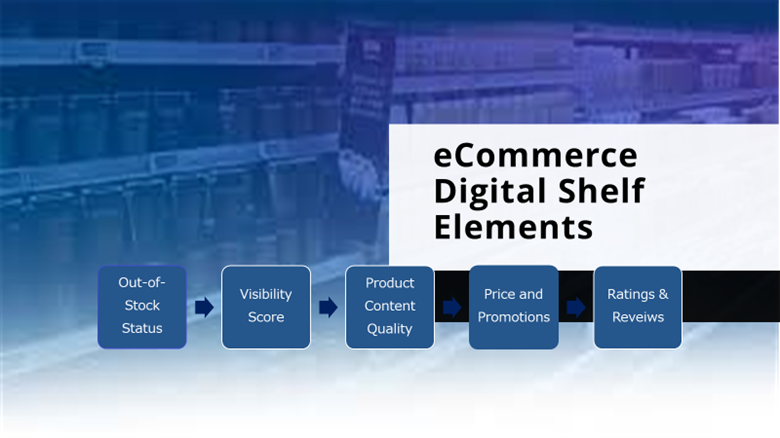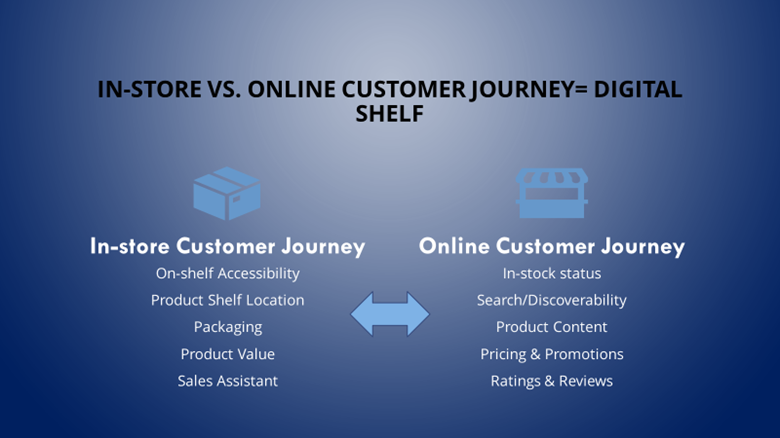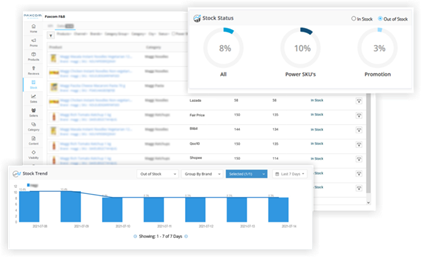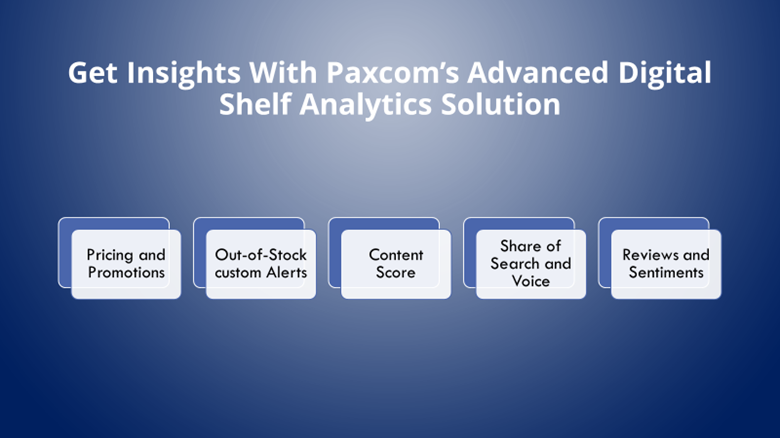When someone walks into a brick-and-mortar store, they may or may not know precisely what they’re looking for. It may be that they are looking for a specific category of products or want a specific brand. They might need to ask an associate for help, or they may just head to the section they need and start comparing products on the shelf.
The digital shelf is how and where a brand’s products are displayed online. In essence, it mimics the way someone shops in a brick-and-mortar store. Most marketers, however, consider the digital shelf part of the entire shopping experience. You can describe it as covering the whole consumer journey, from finding your business to purchasing your product. That includes everything from search engines to how consumers navigate your website, how they find your products, and how they buy them.
Table of Contents
What are the components of the digital shelf?

Importance of Digital Shelf for Brands
- 90% of users use Amazon for product discovery.
- 45% of users don’t even scroll past the first and second pages.
- Nearly 9 out of 10 read reviews before making a purchase decision.
- 65% of shoppers look up price comparisons on their mobile devices while shopping in-store.
- 50% said detailed content is a crucial factor when searching through the digital shelf and making an informed purchase decision.
(Source: SEJ, eMarketer, Statista)
How do in-store shelf metrics mimic digital shelves?

What are the roadblocks to maintaining a Digital Shelf for brands?
- Ranking on the top of the page, i.e., the visibility.
- Inaccurate product content, and inconsistent.
- Maintaining optimum inventory levels.
- Poor visibility into customer reviews.
- Uncurated and non-targeted product assortments.
- No benchmark against competitor pricing.
- Fragmented technology and Data.
How to Win the Digital Shelf?
1. Optimize your online visibility for top rankings
The race to be noticed is immense, and it indeed is very competitive. And like mentioned above how 45% of users don’t even scroll past two pages. Organic strategies and paid advertising can complement each other to deliver the desired results faster when it comes to visibility.
Organic ranking would include maintaining your account health and having accurate product content that reaches customers at the right time. Additionally, paid advertising will help you move up the visibility ladder faster, as well as drive sales lift, which will again translate into organic growth.
In order to enhance the visibility of your products, you need adequate data to analyze what is working for you, and what the gaps are that need to be filled. Stock reviews, ratings, content, and promotions directly impact visibility. Marry these metrics to optimize your visibility for top rankings.
The advanced digital shelf analytics allow you to compare all the necessary KPIs of your and competitors’ to make data-backed decisions and have scalable growth.
2. Maintain detailed and accurate product content
If we take Amazon as a base, 90% of users discover products on Amazon now. So, it becomes essential to focus on your product content copy.
A basic hygiene check for your listings is very crucial-
- Whether your title is accurate or not.
- Does it include SEO-rich keywords?
- Does it have a primary image, lifestyle images, and packshots?
- If it’s a food product- does the description showcase how to be used or any special instructions to be taken care of (Very important for baby food).
- Making use of all the sections available in each retailer’s product content, such as bullet points, enhanced content, Amazon’s A+ content, videos, Q&As, etc.
- Content optimization for all channels, devices, and screen resolutions.
With Paxcom’s content score feature, you can perform regular content audits to identify, quickly compare, and address product display page content shortcomings. With it, you can generate scorecards that determine whether your product’s information is complete and accurate to improve discoverability and buyability, as well as identify gaps that need to be filled.
3. Maintain optimum inventory level to decrease supply chain inefficiencies
The consumer has looked at your product details and your great images. They click the link to “buy” the product, and all of a sudden, an “out of stock” message appears, and now the consumer feels frustrated, or worse, they feel that they wasted their time and switched to your competitor instead. Shoppers are alienated from brands when their favorite products are out of stock. A brand or retailer loses out, too, as they are essentially turning away a customer who is ready to buy from them. Having a data-driven solution to solve the problem of being out of stock or overstocked is the most effective way to solve this problem.
Just to put an impact on how stockouts can change your sales game, a recent report by Bed, Bath & Beyond indicated that they suffered a $175 sales loss due to it.
As part of Paxcom’s OOS alert feature, you can be notified when your in-stock rates are low for all your online retailers, so you can restock ahead of time and not miss out on any sales.

4. Maintain competitive pricing and keep an eye out for your competitors
The price is still the primary factor influencing shoppers when it comes to selecting a product in today’s fiercely competitive eCommerce market. In part because of this, sophisticated players like Amazon periodically review their pricing to ensure that they are strategically priced. Moreover, brands and retailers can lose sales by overpricing products or lose margins by underpricing them. Striking a perfect balance is what you need to do with comparison shoppers and dynamic marketplaces.
You need to track competitor prices and utilize analytics software to take advantage of any pricing or assortment gaps left by competitors. Ensure that your tool is equipped with data points, including historical sales data, operation costs, and SKUs. Benchmark your pricing with exact competitors and similar products for a robust strategy.
5. Ratings & Reviews
The ratings and reviews brands receive reflect how our products and services are perceived by our customers. This can allow us to identify potential issues. Reviews are taken into account by many algorithms when determining relevance and popularity rankings, which, in turn, impacts sales.
The importance of ratings and reviews is that they give us insight into consumers’ reactions to our products.
- Are we getting enough reviews?
- What is the sentiment of those reviews?
- What is the product’s likability?
Most retailers, however, fail to track customer reviews or even the ones that are negative. It can be detrimental to the customer perception of a brand and product if negative customer reviews are not visible. You should strengthen your customer reviews. Your brand should have a sentiment analysis technology that consolidates all consumer-generated content, such as reviews and ratings, into one platform to simplify management. With these tools, you can identify areas of improvement, set goals for positive and negative reviews, and compare the customer’s experience with that of competitors.
P.S. By collaborating with our eCommerce experts, brands can lower churn, gather feedback, and create reports that are specific to their needs.
6. Invest in technology and tools to strengthen digital shelf presence
Every brand needs data to know what actions will drive the most noticeable results on the digital shelf. The eCommerce race is won by brands and retailers who take advantage of technology for customer and competitor data. Amazon, Walmart, Flipkart, and Target are just a few examples of retailers who have leveraged data and analytics to gain an edge. It is one area that has been less explored but is fast gaining importance. To stay competitive and thrive in the evolving retail environment, brands and retailers need advanced digital shelf analytics.
Paxcom’s eCommerce analytics solution

Paxcom’s eCommerce analytics software, Kinator, visualizes any available data into an interactive, visual format to help brands make intelligent, strategic decisions. With a customizable dashboard that can be accessed anywhere, anytime, it is possible to filter by Channel, Category, Brand, Focus SKU, Timeframe, City, and more.
Additionally, it may take a dedicated eCommerce team or a lot of resources to properly handle the digital shelf across all retailers that you do not have access to; Our eCommerce experts can help you fill in the gaps and start working towards implementing actionable plans to grow their businesses.
Schedule a demo to see how Paxcom can help you with digital shelf analytics.
contact us at info@paxcom.net.












